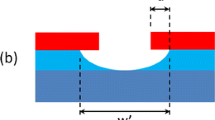Abstract
Micro-contact printing (μCP) technique has been widely used for generating micro-scale patterns of biomolecules for patterning live cells. The contact-printing process is carried out in air, while most of the biomolecules including proteins and antibodies should be handled in a solution to preserve their bioactivity. Here we attempted to print biomolecules under aqueous conditions by modifying certain steps that are known to be critical for the bioactivity. The proposed contact-printing process is as follows: After inking the stamp with biomolecule in a solution, the stamp was rinsed in ultra-sonication bath to remove excessive inked biomolecules on the stamp and the following contact-printing process (‘stamping’) was carried out in a buffered solution. By this way, inked biomolecules were consistently handled under a well-defined aqueous condition. Results showed that high-resolution micropatterns of biomolecules can be printed under the aqueous condition (aqueous micro-contact printing, aq-μCP) and it was readily applicable for patterning neuronal cell cultures. Using the modified process, we were able to print widely separated patterns (2 μm-wide lines with 400 μm spacing), which was not achievable with conventional μCP. Extracellular matrix proteins (laminin and fibronectin) were readily printed in a few micrometer scale patterns and their biological activities were confirmed by immunoassays and neuronal cell cultures. We also demonstrated that pH sensitive surface biofunctionalization scheme can be implemented with the proposed aq-μCP for patterning neuronal cell cultures. The aq-μCP improves the existing surface patterning strategy by extending printable patterns and proteins for neuronal cell chip design.
Similar content being viewed by others
References
Kumar, A. & Whitesides, G.M. Features of gold having micrometer to centimeter dimensions can be formed through a combination of stamping with an elastomeric stamp and an alkanethiol ink followed by chemical etching. Applied Physics Letters 63, 2002–2004 (1993).
Wilbur, J.L., Kumar, A., Biebuyck, H.A., Kim, E. & Whitesides, G.M. Microcontact printing of self-assembled monolayers: Applications in microfabrication. Nanotechnology 7, 452–457 (1996).
Hidber, P.C., Helbig, W., Kim, E. & Whitesides, G.M. Microcontact printing of palladium colloids: Micronscale patterning by electroless deposition of copper. Langmuir 12, 1375–1380 (1996).
Jeon, N.L. et al. Patterned polymer growth on silicon surfaces using microcontact printing and surface-initiated polymerization. Applied Physics Letters 75, 4201–4203 (1999).
Nam, Y., Chang, J.C., Wheeler, B.C. & Brewer, G.J. Gold-coated microelectrode array with thiol linked self-assembled monolayers for engineering neuronal cultures. IEEE Trans. Biomed. Eng. 51, 158–165 (2004).
Bernard, A. et al. Printing patterns of proteins. Langmuir 14, 2225–2229 (1998).
Bernard, A., Renault, J.P., Michel, B., Bosshard, H.R. & Delamarche, E. Microcontact printing of proteins. Adv. Mater. 12, 1067–1070 (2000).
Kane, R.S., Takayama, S., Ostuni, E., Ingber, D.E. & Whitesides, G.M. Patterning proteins and cells using soft lithography. Biomaterials 20, 2363–2376 (1999).
Wilhelm, T. & Wittstock, G. Generation of periodic enzyme patterns by soft lithography and activity imaging by scanning electrochemical microscopy. Langmuir 18, 9485–9493 (2002).
Lange, S.A., Benes, V., Kern, D.P., Horber, J.K.H. & Bernard, A. Microcontact printing of DNA molecules. Anal. Chem. 76, 1641–1647 (2004).
Ingham, C. et al. High-resolution microcontact printing and transfer of massive arrays of microorganisms on planar and compartmentalized nanoporous aluminium oxide. Lab. Chip 10, 1410–1416 (2010).
Jiang, X.Y., Bruzewicz, D.A., Wong, A.P., Piel, M. & Whitesides, G.M. Directing cell migration with asymmetric micropatterns. Proc. Natl. Acad. Sci. U.S.A. 102, 975–978 (2005).
Singhvi, R. et al. Engineering cell-shape and function. Science 264, 696–698 (1994).
Xu, L.P. et al. Microcontact printing of living bacteria arrays with cellular resolution. Nano Lett. 7, 2068–2072 (2007).
Ashton, R.S. et al. High-throughput screening of gene function in stem cells using clonal Microarrays. Stem Cells 25, 2928–2935 (2007).
Shi, P., Shen, K. & Kam, L.C. Local presentation of L1 and N-cadherin in multicomponent, microscale patterns differentially direct neuron function in vitro. Dev. Neurobiol. 67, 1765–1776 (2007).
Chang, J.C., Brewer, G.J. & Wheeler, B.C. A modified microstamping technique enhances polylysine transfer and neuronal cell patterning. Biomaterials 24, 2863–2870 (2003).
James, C.D. et al. Patterned protein layers on solid substrates by thin stamp microcontact printing. Langmuir 14, 741–744 (1998).
Oliva, A.A., James, C.D., Kingman, C.E., Craighead, H.G. & Banker, G.A. Patterning axonal guidance molecules using a novel strategy for microcontact printing. Neurochem. Res. 28, 1639–1648 (2003).
Delamarche, E. et al. Microfluidic networks for chemical patterning of substrate: Design and application to bioassays. J. Am. Chem. Soc. 120, 500–508 (1998).
Folch, A., Jo, B.H., Hurtado, O., Beebe, D.J. & Toner, M. Microfabricated elastomeric stencils for micropatterning cell cultures. J. Biomed. Mater. Res. 52, 346–353 (2000).
Mooney, J.F. et al. Patterning of functional antibodies and other proteins by photolithography of silane monolayers. Proc. Natl. Acad. Sci. U.S.A. 93, 12287–12291 (1996).
Kang, K., Choi, I.S. & Nam, Y. A biofunctionalization scheme for neural interfaces using polydopamine polymer. Biomaterials 32, 6374–6380 (2011).
Bessueille, F. et al. Submerged microcontact printing (SμCP): An unconventional printing technique of thiols using high aspect ratio, elastomeric stamps. Langmuir 21, 12060–12063 (2005).
Lee, H., Dellatore, S.M., Miller, W.M. & Messersmith, P.B. Mussel-inspired surface chemistry for multifunctional coatings. Science 318, 426–430 (2007).
Falconnet, D., Csucs, G., Grandin, H.M. & Textor, M. Surface engineering approaches to micropattern surfaces for cell-based assays. Biomaterials 27, 3044–3063 (2006).
Author information
Authors and Affiliations
Corresponding author
Rights and permissions
About this article
Cite this article
Jang, M.J., Nam, Y. Aqueous micro-contact printing of cell-adhesive biomolecules for patterning neuronal cell cultures. BioChip J 6, 107–113 (2012). https://doi.org/10.1007/s13206-012-6201-9
Received:
Accepted:
Published:
Issue Date:
DOI: https://doi.org/10.1007/s13206-012-6201-9




